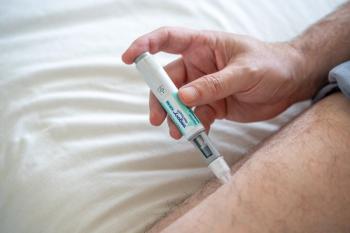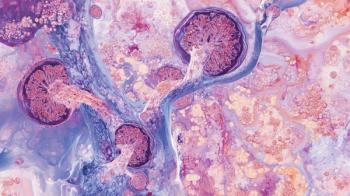CASE 1
Dry Mouth
MJ, a patient aged 55 years, comes to the pharmacy complaining of a dry mouth that has been bothersome for the past month. MJ reports noticing a connection between starting paroxetine (Paxil; GSK) and having these symptoms. The antidepressant is helping MJ’s mood symptoms greatly. MJ reports having a mouth that feels sticky, as well as being thirsty and having worse breath than usual. MJ’s medical history includes depression and hypertension.
Q: How would you advise this patient?
A: MJ likely has dry mouth (xerostomia), which could be an adverse effect of paroxetine. At this time, the symptoms appear mild and may be due to reduced salivary flow. The symptoms must be managed for MJ’s comfort and because, if left untreated, there is a higher risk of cavities, demineralization of teeth, sensitivity, or oral infections.1 The goal of treatment is to find the underlying cause, which in MJ’s case is most likely the paroxetine. Because the patient does not want to discontinue paroxetine, xerostomia may be treated with saliva substitutes. These are available in different dosages and forms, including lozenges, liquids, and sprays. MJ can also be advised to chew sugar-free gum and brush teeth with a fluoridated toothpaste at least twice daily. If symptoms do not get better, MJ should be advised to see a health care provider.
About the Authors
Rupal Patel Mansukhani, PharmD, FAPhA, NCTTP, is a clinical professor of pharmacy practice and administration at Ernest Mario School of Pharmacy at Rutgers, The State University of New Jersey, in Piscataway and a transitions-of-care clinical pharmacist at Morristown Medical Center.
Sneha Baxi Srivastava, PharmD, BCACP, CDE, is associate director of skills education at Rosalind Franklin University of Medicine and Science’s College of Pharmacy in North Chicago, Illinois. She is deeply passionate about embracing the pillars of lifestyle medicine, self-care, effective communication, and inclusivity to create lasting positive health and wellness outcomes.
CASE 2
Infant Teething
A father comes to the pharmacy with his 8-month-old baby, JM, who is experiencing noticeable discomfort due to teething. JM is irritable, drools excessively, has trouble sleeping, and has low-grade fevers. The father mentions that the baby is constantly chewing on fingers and toys; he suspects the baby’s top front teeth are coming in. Their pediatrician said they can give the baby some acetaminophen, which they have already done, and ensure that the baby is feeding adequately.
Q: What is a safe and effective way to relieve his baby’s pain?
A: As the father noted, the symptoms JM is experiencing are most likely due to teething, which can be painful and can be managed with nonpharmacological methods. Recommendations include using teething rings; placing them to chill in the refrigerator may provide extra relief, but the father should make sure they are not frozen, as that can be painful. Additionally, gently massaging JM’s gums may be helpful, but he should ensure the finger used to massage has been washed with soap and water. There are OTC teething gels that contain benzocaine or lidocaine, but they have been shown to have minimal efficacy and are associated with adverse effects when used for teething pain in infants. For example, benzocaine may lead to methemoglobinemia, which, although rare, can be fatal in children.2 If JM’s fever or symptoms worsen, if his eating habits change, or if the symptoms do not subside even as teeth emerge, JM’s dad should be advised to call the pediatrician.
CASE 3
Dental Abscess
LK, a man aged 50 years, visits the pharmacy reporting severe tooth pain that started 2 days ago, along with swelling and pus near the lower right molar. LK says it is difficult to open his mouth fully, he feels a throbbing sensation, and he rates the pain an 8 out of 10. LK also has a headache, which he believes is related to tooth pain. He has not experienced this in the past and is unsure when he will be able to see his dentist because it is the weekend.
Q: LK has a history of high blood pressure and diabetes.
A: This patient likely has a dental abscess and potentially an infection. The presence of swelling, pus, and difficulty opening the mouth indicates that the infection may be spreading. LK should be urged to see his dentist as soon as possible. In the meantime, given his cardiovascular risk factors, LK can be given acetaminophen to temporarily relieve the pain. He can also do saltwater rinses.3
It is important to tell LK that the pain may not totally dissipate with the acetaminophen, but the drug may be helpful in reducing the pain and treating the headache. Encourage LK to try calling the dentist immediately because someone may be on call; if not, he should call again as soon as possible.
CASE 4
Denture Care
Q: GM comes to the pharmacy asking how to best help her grandmother take care of her dentures. GM recently became her grandmother’s caretaker and is at the pharmacy looking for products to clean dentures. Her grandmother has had dentures for 2 years and independently managed them. Because her grandmother recently had a stroke, GM will now be helping her. She states that her grandmother is not reporting any issues, including pain, foul smell, or discomfort in her mouth.
A: GM should be advised that dentures should be cleaned thoroughly at least once daily to remove stains, debris, and plaque. She should use a denture-specific brush and an appropriate cleanser, and the dentures should be soaked in a chemical cleanser for no longer than 10 minutes. GM should not vigorously scrub the dentures because she may damage the dentures’ acrylic and metal parts. She should rinse the dentures well after cleaning to avoid irritation, and never use household cleaners, whitening toothpaste, or hot water, as these can cause damage or warping. GM should also ensure her grandmother removes the dentures before sleeping to reduce plaque buildup.4
REFERENCES
1. Xerostomia (dry mouth). American Dental Association. Updated April 24, 2023. Accessed July 16, 2025. https://www.ada.org/resources/ada-library/oral-health-topics/xerostomia
2. Safely soothing teething pain in infants and children. FDA. June 26, 2024. Accessed July 16, 2025. https://www.fda.gov/consumers/consumer-updates/safely-soothing-teething-pain-infants-and-children
3. Lockhart PB, Tampi MP, Abt E, et al. Evidence-based clinical practice guideline on antibiotic use for the urgent management of pulpal- and periapical-related dental pain and intraoral swelling: a report from the American Dental Association. J Am Dent Assoc. 2019;150(11):906-921.e12. doi:10.1016/j.adaj.2019.08.020
4. Knockel L. Prevention of hygiene-related oral disorders. In: Krinsky DL, ed. APhA OTC – Ophthalmic, Otic, and Oral Disorders. American Pharmacists Association; July 2024. Accessed July 16, 2025. https://pharmacylibrary.com/doi/10.21019/aphaotc-ophthal.oral-disorders





